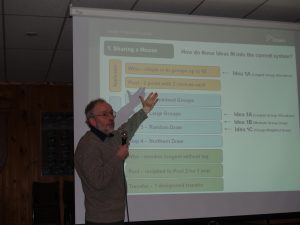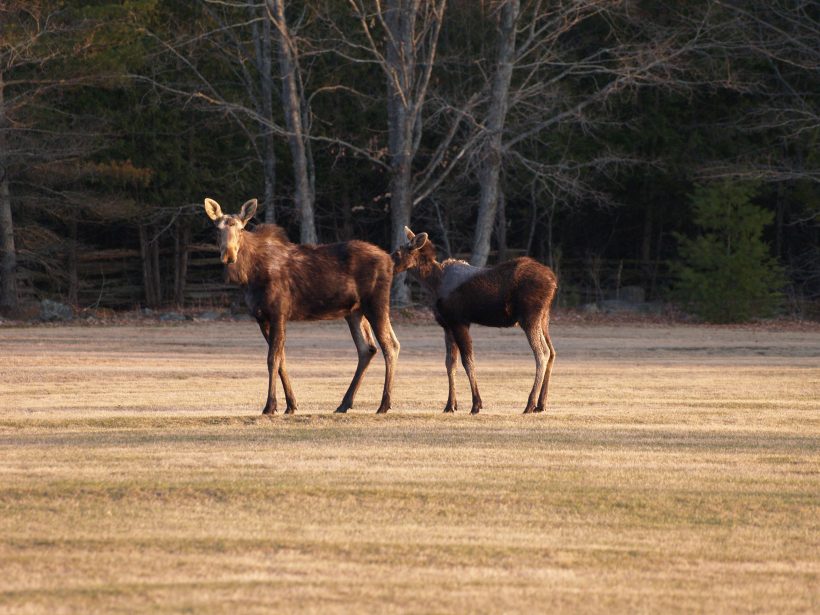ABOUT MOOSE by Ralph Bice
From October 12, 1977
It is not so uncommon these days to see a moose in the wilds. Years ago there were not so many moose in the area as there are to-day. They seem to have appeared in the last fifty years and at times there are quite a few in the woods. The first ever I saw was in 1913 when two bull moose were being loaded on the train here in Kearney (‘Carney’). They had been shot near Willow Lake by a hunting party guided by the late Frank Groom,Sr. Later I was told that every season two or three moose were shipped out in that section of hunting territory between Kearney and Algonquin Park.
Bulls only were allowed to be killed, and perhaps if there had been a season on cows more would have been shot. Only thing, they did not seem to get any more plentiful. This would hold true of Algonquin Park as a moose was seldom seen except on the Nipissing or the Pine (now called the Tim) River. I do remember that in the two months that deer were hunted in Algonquin Park in the fall of 1917 not one moose was taken. In fact, dad and I never saw a single moose track.
(Note: In the early 1980s when moose were shipped to Michigan’s Upper Peninsula for their re-introduction initiative the estimated population of moose in A.P. numbered 4000. Deer were non-existent. Ed.)
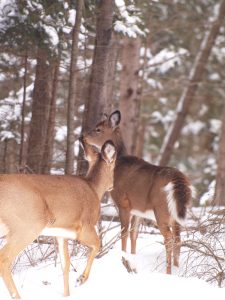
We had a very severe winter 1922-23 and many deer died. Not quite as heavy a die-off as we had in 1959 and 1960 but a lot of deer died. Then the rest just seemed to disappear. Perhaps as the result of the new growth that came as a result of those heavy fires in 1922. Then, for some reason, the moose in the course of a few years got very plentiful. In McCraney Township the moose population showed a decided increase. There was very little hunting. The deer were so scarce that few of the hunt camps had hunters during the fall season. There were fewer wolves than there were 30 years later and the woods seemed to be full of moose. Then for a couple of seasons the moose hunting was poor in the north so south of the French and Mattawa Rivers a closed season was imposed. When asked why we were told it was feared something drastic was happening to the moose in the far north and this herd had to be saved. Then about 1933, just when the deer were returning to the woods something happened to the moose and they had a heavy die-off. (Perhaps the brain worm carried by deer? Ed.)
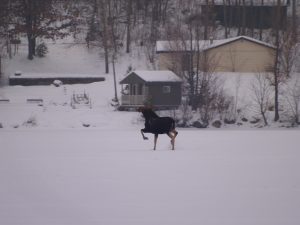
The heaviest concentration of moose was perhaps in Devine Township. I know that a biologist was sent in and he found many carcasses of moose. There was no way to determine the cause of death. There is no way to know for certain but it appeared that 90% of the moose herd died.
By 1950 they were getting more numerous and we kept asking for an open season which was finally granted. Since the deer again were getting scarce moose increased (brain worm? Ed.) and now we have a season every second fall and a lot of moose are taken. A few are killed by wolves but with the season open only every second year the number of moose in the woods seems to keep on about the same level. The fact that many like to feed in the marshes and lakes along the road going to Rain Lake many visitors and local people get a chance to see a few of these largest members of the deer family.
Some writers have stated that moose are really new to this area but as I said some were taken before the first war, Then there is that book “The Sportsman’s Paradise” where the writer tells of a hunting trip in this area and that they saw moose in one piece of woods which by the lakes he mentions must be either in Paxton or Devine Townships and on the eastern side of the divide. So there were some moose around before the settlers moved in.
There was a meeting in Huntsville recently called for the purpose of discussing moose management with hunters, the meeting had not been too well publicized and there were only about 50 hunters there. The speakers from the Ministry of Natural Resources showed some slides and gave us some facts on the moose hunt in various sections of the province. We were also told that in 1978 there would be an open season south of the French planned for October and it would not coincide with the deer season. It was quite evident that nearly all the hunters present would have preferred this part of the province to have remained as a deer hunting area.
Everyone present was invited to present a brief containing their suggestions as to what should be done in order to come up with some sort of moose management plan. I hope a goodly number of briefs were submitted and that moose hunting in the future will be handled in a practical manner.
In all the years I have been in the woods I have never been lucky enough to have heard two moose fighting. I have found several sets of locked antlers where these huge animals have met head on and antlers spread enough to fasten so tightly they could not be pulled apart and that meant death for both animals.
It was really surprising years ago when there were telephone lines to most of the shelter huts how many moose got their antlers tangled in said telephone wires and men hunting for the break in a line would find a dead moose. So many that the lines were taken down.
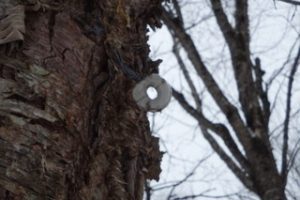
It’s not nice thinking that this area once just about the best deer hunting area in the province being considered a moose hunting district. But if it has to happen lets hope that we can have a sensible plan of management.
